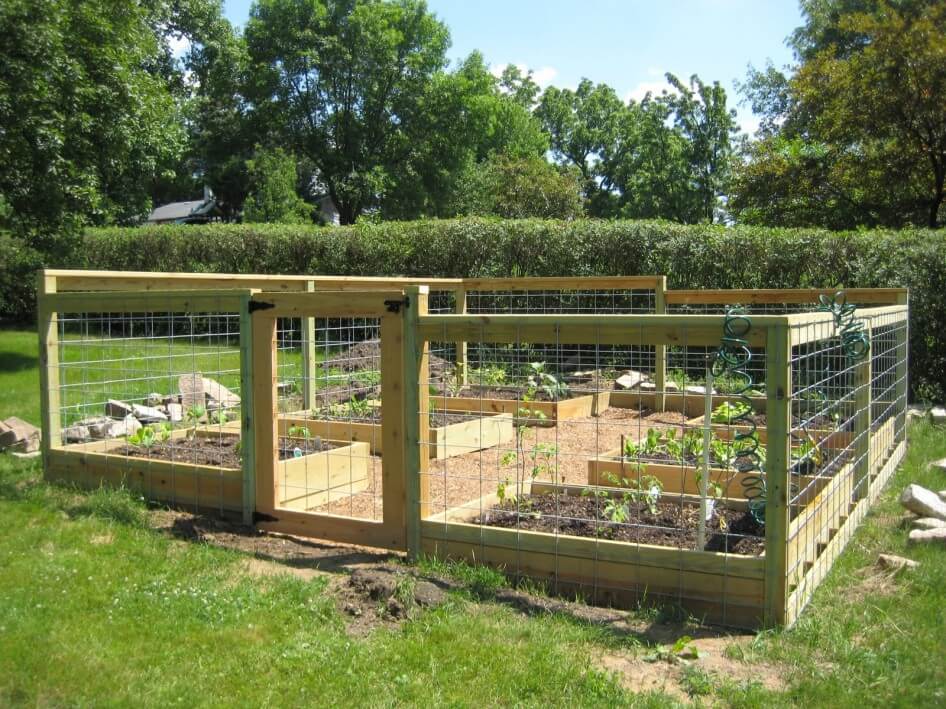Fortress Max
 Throughout history humans have built forts or fortresses to protect themselves and their livestock from marauders, Neanderthals (our first cousin) and other animals. Some were quite elaborate with moats, turrets and drawbridges.
Throughout history humans have built forts or fortresses to protect themselves and their livestock from marauders, Neanderthals (our first cousin) and other animals. Some were quite elaborate with moats, turrets and drawbridges.
Then there is Max’s.
There are gardeners, and then there are serious gardeners. Max is in the latter category. He built a fantastic vegetable raised-bed garden inside an enclosure. No moats or turrets but nonetheless impressive.
I had a chance to chat with him.
Why did you build this?
My wife and I grew up with big family gardens and had gardens at our previous houses. We knew we would have a garden at our new house and expected we would need some sort of fences to keep the critters out. We wanted something durable that would both last and look presentable. She asked me to build the structure. She is the actual gardener.
How did you plan for it? Were there models? Did you have plans?
I had a rough idea. We initially had the ground tilled and a few truckloads of compost added to our lovely clay soil. Everything else just kind of came as we went along from a couple of drawings that I made. Susan, thankfully, talked me into making it about half the size of what I had originally planned for and had tilled.
What preparations did you make?
Nothing more than what I mentioned above, in terms of the initial compost. Our land was pretty level, but our soil doesn’t support much more than field grass. We started with the fence first. The raised beds came later.
What materials did you need and where did you find them?
I calculated what I’d need for fence posts and the crossing posts and called Koenig Cedar in South Burlington. They delivered all of it. The initial fencing and hardware I just picked up at Aubuchon and Lowes. We added to the fencing over the years. We initially buried much of the fencing but discovered we needed to go down further to keep out the rabbits. (It also helps that we have large dogs.) Other than the added fencing we haven’t needed to do much to maintain the fence.
What did you learn from this?
That building a fence is a lot of work. It’s hard to put fence posts in two feet deep when rock starts at 18 inches. It is imperative to keep fingers out of the way when you are breaking up the rocks. I learned that the very hard way.
How did you decide what to plant?
That is usually Susan’s job. She is pretty traditional or at least plants the things we grew up with…tomatoes, cucumbers, peas, beans, beets, carrots, kale greens and squash. I tend to plant the garlic, potatoes, onions, leeks and peppers. We have actually planted less and less each year but seem to produce more as we get better and learn what works for us. We also have and consult garden books that we’ll look at in the winter to learn from the real professionals.
How do you maintain the quality of the soil?
We have a small compost pile and have amended it with more compost from Steve Wisbaum each of the last few years. We quickly realized we would have more success with raised beds, so I built those. The raised beds also helped contain our habit of planting way more than we need. Of course, we also plant outside the fence, where there are potatoes, squash, pumpkins and herbs.
What worked best and what would you do again?
I don’t know that we would do anything differently. Getting the lumber and fencing supplies was easy, as was building the raised beds. It has taken a while to get our soil where we want it, but after five years we had a successful summer, growing nearly all of our own produce and giving quite a bit to others.
Does this mean that instead of the $100 tomato we have the $1,000 tomato?
We’ve never really kept track of how much our produce actually costs us, but nothing replaces the joy of walking out the door to get most of our produce for about half the year. Our annual costs aren’t that much: plants, seeds, compost, mulch and hay. The original fence was more expensive, but it is still in good shape after five years. Hopefully it will last many more. It is definitely worth the investment!

